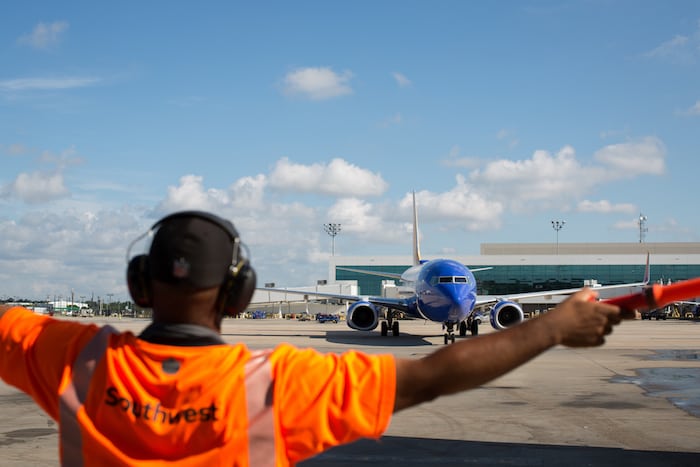
A Southwest Boeing 737 at Houston Hobby Airport. (Southwest Airlines)
The price of jet fuel is currently 36.5% higher than it was one year ago. Commercial airlines are reducing the number of flights on certain routes and considering increased fares to offset the increased operational costs from fuel prices.
On Tuesday, American Airlines announced it would suspend service between Chicago and Shanghai in October due to the “current fuel and competitive environment.” American is also reducing daily routes from Chicago to Narita International Airport in Japan from daily to three times weekly in December.
American’s announcement came on the same day Hawaiian Airlines suspended service from Honolulu to Beijing. On Wednesday, Qantas Airways reported record earnings of $1.6 billion for its 2018 fiscal year. However, the Australian carrier expects its fuel spending to increase by $690 million in the next fiscal year.
Other airlines are using a variety of strategies to combat the increased cost of jet fuel, while trying to avoid increasing fare prices charged to passengers. Some, like Southwest Airlines, will not see a major impact from the increase, as their organization has already adjusted to the increase in fuel costs that occurred several years ago.
“We had to really overhaul the company during the era of higher fuel costs earlier this decade,” Andrew Watterson, Southwest Airlines SVP, told Avionics during an interview at the 2018 International Aviation Forecast Summit.
Fuel costs for Southwest increased by $241 million during the first half of 2018 according to the airline’s second-quarter earnings report. However, Southwest has not had to raise fares because it has been operating at 2014 jet fuel levels, the final year before prices dropped, rather than adjusting in the interim.
According to the U.S. Bureau of Transportation Statistics, spending on kerosene-based aviation fuel by U.S. passenger airlines collectively fell by $16.5 billion between 2014 and 2015. In 2015, the cost of jet fuel dropped to $1.53 per gallon, compared to the average of $2.92 per gallon between 2011 and 2014.
“We’ve structured our company to be profitable at higher fuel costs, we’ve absorbed that increase to some extent, but we’re still making sure that our non-fuel costs behave correctly,” Watterson said. “I think you will see an increased focus on that from a lot of airlines. But, it’s not something you do all at once; it’s what you do over a year or two.”
Reaction to the increased cost of jet fuel varies based on where airlines fly, how frequently they fly and the type of customer they serve. Other factors include transitions to newer, more fuel-efficient aircraft.
Allegiant Air, for example, will be replacing its legacy fleet of MD-80s with an all-Airbus fleet of more fuel-efficient A320s and A319s by the end of the year. Drew Wells, VP of revenue for Allegiant, said the Las Vegas-based carrier will consider reducing some of its flying on Tuesdays and Wednesdays where demand is not as high.
“We still have a very price-sensitive customer, and it’s very hard to pass through any sort of fare increase whether its driven by fuel or otherwise, the best lever we have to pull is to drop capacity a little bit and then have fares naturally change that supply-and-demand balance,” said Wells.
The economic situation in countries such as Argentina, Brazil and Venezuela put different pressures on Latin American airlines. While Panama City, Panama-based Copa Airlines is facing higher fuel prices, many of the passengers it serves simply cannot afford an increase in fares, says Copa SVP of commercial and planning Dennis Cary.
Spending on jet fuel increased by 50% during the second quarter for Copa. Cary attributes 35 points of that increase to the higher cost of fuel itself, with the remaining 15 points attributed to Copa burning more fuel because it flew more available seat miles than the same period in 2017.
The Copa executive said the airline does not engage in fuel hedging as the strategy has never worked for them in the past. Cary said he expects Copa and other airlines to adjust capacity between September and November when demand for flights naturally comes down.
“I’m sure we will see the same from some of our competitors because the market is soft relative to these higher operating costs and basic supply and demand says supply has to get retracted,” Cary said.